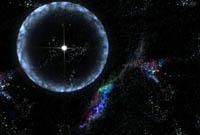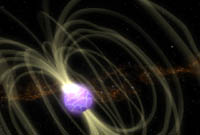Imagine the Universe News - 25 February 2005
Cosmic Explosion Among the Brightest in Recorded History
| 25 February 2005 |

|
| Artist conception of the December 27, 2004 gamma ray flare expanding from SGR 1806-20 and impacting Earth's atmosphere. Click on image to view animation (2.4 MB). Credit: NASA |
Scientists have detected a flash of light from across the Galaxy so powerful that it bounced off the Moon and lit up the Earth's upper atmosphere. The flash was brighter than anything ever detected from beyond our Solar System and lasted over a tenth of a second. NASA and European satellites and many radio telescopes detected the flash and its aftermath on December 27, 2004.
The scientists reporting the event said the light came from a "giant flare" on the surface of an exotic neutron star, called a magnetar. The apparent magnitude was brighter than a full moon and all star explosions seen in the past. The light was brightest in the gamma-ray energy range, far more energetic than visible light or X-rays and invisible to our eyes.
Such a close and powerful eruption resurrects questions on the nature of gamma ray bursts and their potential effect on earth. Could a very close gamma ray burst, or one with even larger influx of gamma rays, have disturbed the atmosphere and be responsible for one of the mass extinctions known to have occurred on Earth hundreds of millions of years ago? Also, if giant flares can be this powerful, then could some gamma-ray bursts actually be from neutron star eruptions in nearby galaxies, rather than from far distant galaxies (as is commonly thought)?
NASA's newly launched Swift satellite and the NSF-funded Very Large Array (VLA) were two of many observatories that observed the event in December, which came from the neutron star SGR 1806-20, about 50,000 light years from Earth in the constellation Sagittarius.

|
| An artist conception of the SGR 1806-20 magnetar including magnetic field lines. After the initial flash, smaller pulsations in the data suggest hot spots on the rotating magnetar's surface. The data also shows no change in the magnetar's rotation after the initial flash. Click on image to view animation (3.4 MB). Credit: NASA |
"This might be a once-in-a-lifetime event for astronomers, as well as for the neutron star," said Dr. David Palmer of Los Alamos National Laboratory, lead author on a paper describing the Swift observation. "We know of only two other giant flares in the past 35 years, and this December event was one hundred times more powerful."
Dr. Bryan Gaensler of the Harvard-Smithsonian Center for Astrophysics in Cambridge, Mass., is lead author on a report describing the VLA observation, which tracked the ejected material as it flew out into interstellar space. Other key scientific teams are associated with radio telescopes in Australia, The Netherlands, United Kingdom, India and the United States, as well as with NASA's High Energy Solar Spectroscopic Imager (RHESSI).
A neutron star is the core remains of a star once several times more massive than our Sun. When such stars deplete their nuclear fuel, they explode -- an event called a supernova. The remaining core is dense, fast-spinning, highly magnetic, and only about 15 miles in diameter. Millions of neutron stars fill our Milky Way galaxy.
Scientists have discovered about a dozen ultrahigh-magnetic neutron stars, called magnetars. The magnetic field around a magnetar is about 1,000 trillion gauss, strong enough to strip information from a credit card at a distance halfway to the moon. (Ordinary neutron stars measure a mere trillion gauss; the Earth's magnetic field is about 0.5 gauss.)
Four of these magnetars are also called soft gamma repeaters, or SGRs, because they flare up randomly and release gamma rays. Such episodes release about 1030 to 1035 watts for about a second, or up to millions of times more energy than our Sun. For a tenth of a second, the giant flare on SGR 1806-20 unleashed energy at a rate of about 1040 watts. The total energy produced was more than the Sun emits in 150,000 years.
"The next biggest flare ever seen from any soft gamma repeater was peanuts compared to this incredible December 27 event," said Gaensler. "Had this happened within 10 light years of us, it would have severely damaged our atmosphere. Fortunately, all the magnetars we know of are much farther away than this."
A scientific debate raged in the 1980s over whether gamma-ray bursts were star explosions from beyond our Galaxy or eruptions on nearby neutron stars. By the late 1990s it became clear that gamma-ray bursts did indeed originate very far away and that SGRs were a different phenomenon. But the extraordinary giant flare on SGR 1806-20 reopens the debate, according to Dr. Chryssa Kouveliotou of NASA Marshall Space Flight Center, who took part in both the Swift and VLA analysis.
A sizeable percentage of "short" gamma-ray bursts, less than two seconds, could be SGR flares, she said. These would come from galaxies within about a 100 million light years from Earth. (Long gamma-ray bursts appear to be black-hole-forming star explosions billions of light years away.)
"An answer to the 'short' gamma-ray burst mystery could come any day now that Swift is in orbit", said Swift lead scientist Neil Gehrels. "Swift saw this event after only about a month on the job."
Scientists around the world have been following the December 27 event. RHESSI detected gamma rays and X-rays from the flare. Drs. Kevin Hurley and Steven Boggs of the University of California, Berkeley, are leading the effort to analyze these data. Dr. Robert Duncan of the University of Texas at Austin and Dr. Christopher Thompson at the Canadian Institute for Theoretical Astrophysics (University of Toronto) are the leading experts on magnetars, and they are investigating the "short duration" gamma-ray burst relationship.
Brian Cameron, a graduate student at Caltech under the tutelage of Prof. Shri Kulkarni, leads a second scientific paper based on VLA data. Amateur astronomers detected the disturbance in the Earth's ionosphere and relayed this information through the American Association of Variable Star Observers.

